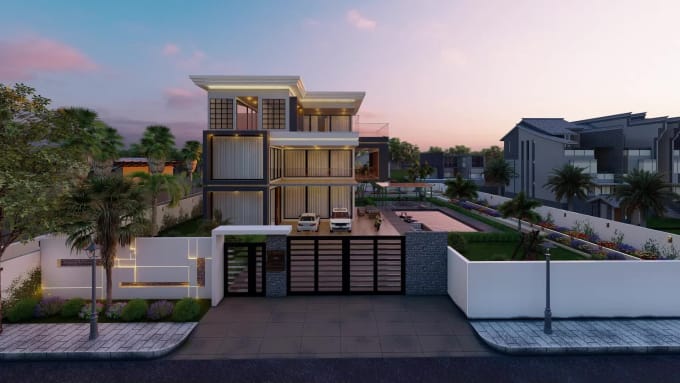Immersive Architectural Design: Unlocking the Power of 3D Modeling and Rendering
I will create architectural 3d modeling and rendering,virtual stage quality over price I will create architectural 3d modeling and rendering,virtual stage Try to read more first

Architectural 3D Modeling and Rendering: A Comprehensive Review
Introduction
Architectural 3D modeling and rendering have become indispensable tools for architects and interior designers, enabling them to visualize and communicate their designs with unprecedented accuracy and realism. This review aims to provide a comprehensive overview of the capabilities, benefits, and limitations of architectural 3D modeling and rendering, exploring the latest advancements and industry trends.
Capabilities and Features
Architectural 3D modeling involves the creation of virtual 3D models that accurately represent a building or space. These models can range from simple geometric shapes to highly detailed representations, capturing the architectural elements, materials, and textures with a high degree of fidelity.
Rendering is the process of converting these 3D models into photorealistic images or animations. Rendered images can convey the intended design with exceptional clarity, allowing architects and designers to share their vision and make informed decisions throughout the project lifecycle.
Benefits of Architectural 3D Modeling and Rendering
- Enhanced Visualization: 3D modeling and rendering provide a superior level of visual representation, enabling architects and clients to fully understand the design concept and its potential impact on the physical environment.
- Improved Communication: Rendered images facilitate effective communication between architects, clients, and contractors, reducing misinterpretations and ensuring alignment throughout the project.
- Virtual Staging: 3D models can be used to create virtual staging environments, showcasing furniture, fixtures, and decorative elements within the virtual space. This enables clients to visualize the finished product and make informed decisions about interior design.
- Marketing and Sales: Photorealistic renderings can be used as powerful marketing and sales tools, captivating potential buyers and attracting investors.
- Cost and Time: Creating high-quality 3D models and renderings can be time-consuming and expensive, especially for complex projects.
- Accuracy: The accuracy of 3D models and renderings depends on the skill and experience of the modeling team. Poorly executed models can lead to inaccurate representations of the design.
- Software Complexity: Architectural 3D modeling and rendering software can be complex to learn and use, requiring specialized training and knowledge.
- Artistic Interpretation: Rendered images are inherently artistic interpretations, and the final appearance may vary from the actual built space due to factors such as lighting, materials, and finishes.
- Real-Time Rendering: Real-time rendering engines allow architects and designers to create interactive 3D experiences, providing a more immersive way to explore and visualize designs.
- Cloud-Based Modeling: Cloud-based platforms enable remote collaboration on 3D models, allowing teams to work on projects regardless of their location.
- Augmented Reality (AR): AR technology is being integrated with 3D models, allowing architects and clients to overlay virtual designs onto the real world, enhancing the design exploration process.
- Artificial Intelligence (AI): AI algorithms are being used to automate certain aspects of 3D modeling and rendering, streamlining workflows and improving efficiency.
li>Early Design Exploration: 3D modeling allows architects to experiment with different design options, test spatial relationships, and optimize the functionality of the space before committing to physical construction.
Limitations and Considerations
Industry Trends and Advancements
The architectural 3D modeling and rendering industry is constantly evolving, with new technologies and trends emerging to enhance the capabilities and efficiency of these tools.
Conclusion
Architectural 3D modeling and rendering are invaluable tools for architects and interior designers, enabling them to visualize and communicate their designs with unprecedented accuracy and realism. While these technologies offer numerous benefits, it is essential to consider the potential limitations and challenges. By leveraging the latest advancements and industry trends, architects and designers can harness the full potential of 3D modeling and rendering to elevate their design processes and deliver exceptional results.
Hi there,
First of all, I want to express my sincere gratitude for taking the time to visit my GIG and leave a positive impression. Making your dreams a reality will be my pleasure as your designer.
For your construction, I will design architectural plans and create photo-realistic 3D model renderings with virtual staging and top-notch renderings of the exterior, interior, or landscaping. I’ll help you design your home staging, which you can use to build your dream home or impress your clients in the real estate business, with the following:
Houses, villas, apartments, studios, flats, commercial and industrial buildings, and infrastructure, also help with photo editing, 2D planning, and 360 virtual visual stagings.
Please take note that if you have any questions about the services I’ve offered, don’t hesitate to contact me before placing your order. We can then have a cordial discussion about the project to make it all come to pass.
With the help of my photo-realistic renderings, I hope you can create an impressive image for whatever kind of audience you have, any experts you collaborate with, such as real estate developers, as well as the project’s investors.
Thank you
👉 I will create architectural 3d modeling and rendering,virtual stage
Leave a Reply